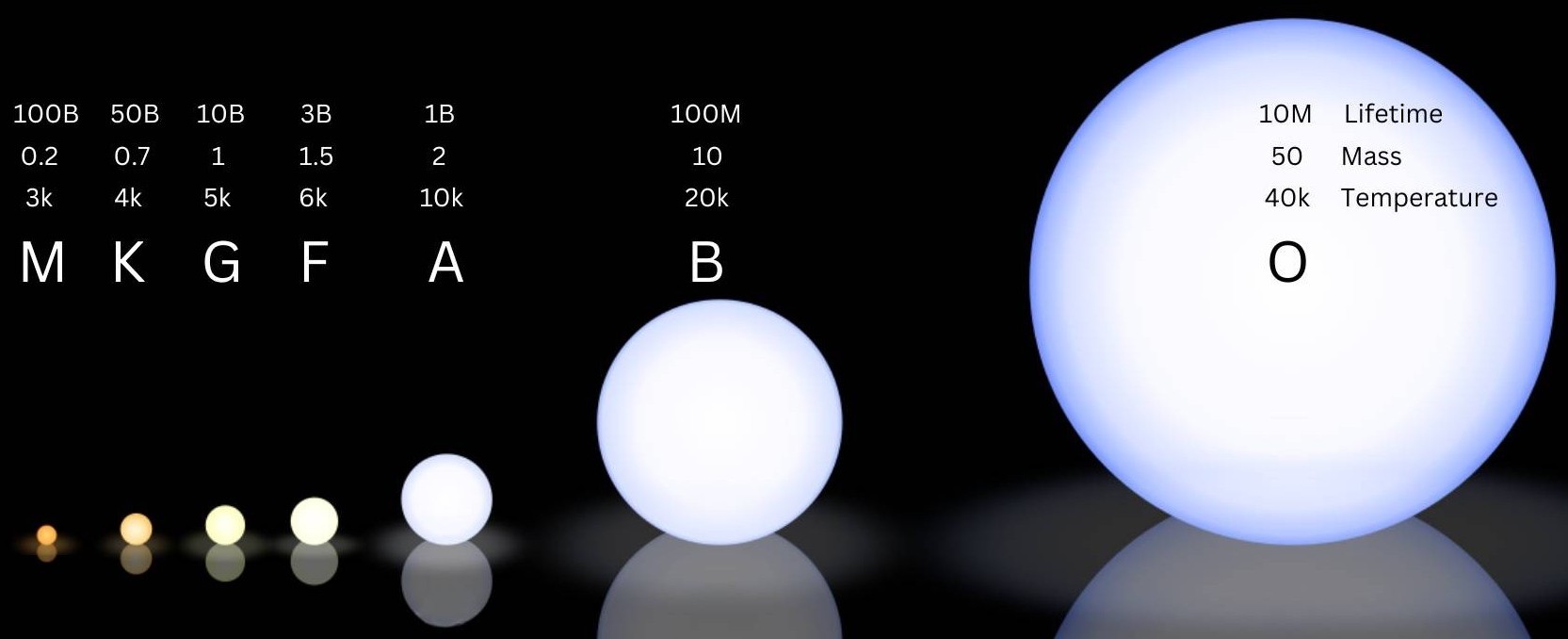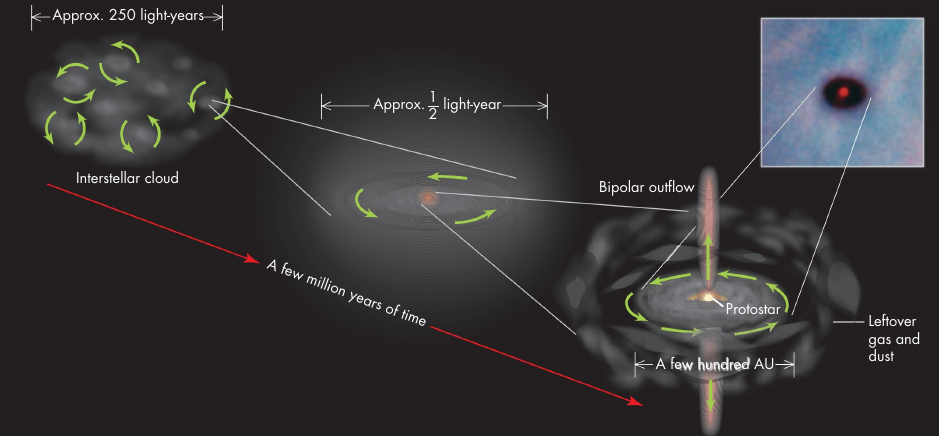Table of Contents
7. Stars from Birth to Death
Stars are nothing but spheres of hot gas, so hot that their centers work like nuclear reactors. Almost 90% of a star is hydrogen, the remaining 10% is helium. There are heavier elements (carbon, nitrogen, oxygen, iron) but in such small quantities that they do not even add up to a fraction worth mentioning here.
There could be as many as 1 septillion (24 zeros after 1) stars in the universe inside all the galaxies.
1. Star types
All stars have the same shape: spherical. So they cannot be classified based on their shape. Stars are classified based on their mass. The mass, radius, temperature and brightness of a star are all interrelated. Bigger stars have more mass and temperature and vice versa.

Stars are labelled by the nice and simple letters O, B, A, F, G, K and M depending on their temperature, mass and size. The biggest, heaviest and hottest star is a O-type star. As you go from O to M, radius, mass and temperature decreases.
The temperature mentioned here is only the surface temperature; temperatures at the core of stars can be millions of degrees.
The mass is shown relative to the sun. The sun is a G-type star, so that type has been given a mass of 1, all other masses are relative to this. So O-type stars can be 50 times heavier than the sun.
The lifetime or lifespan of a star also varies with mass and size. Lifetime is shown in billion and million years. O-type stars are the heaviest and biggest, so they have the shortest lifespan of only around 10 million (10M) years. On the other hand M-type stars can live for as long as 100 billion (100B) years.
O-type stars can have surface temperatures of 40 thousand (40k) degrees celsius. They can be more than 7 times bigger than the sun. The sun has surface temperature of only around 5k degrees as shown above. The types are applicable to a range of temperatures and sizes, not just a specific temperature and size. All stars having a temperature of more than 30k are actually called O-type stars; I have specified 40k just as an example because we are not interested in memorizing exact numbers in this course.
Most stars in the universe are small. There are more K-type and M-type stars in the universe than there are O, B, A and F-type stars. Our little sun is an ordinary average star.
2. Birth
But before death, let us talk about the birth of a star, any star. How do stars form. They form from huge molecular clouds, also called interstellar clouds because they are located in the space between stars. We have already discussed the collapse of a cloud briefly while talking about the formation of planets.
During the formation of a planetary system, the rotating molecular cloud of gas and dust contracts and becomes more and more flat like a disk. The planets are created by fragmenting the disk into many rings. But most of the materials in the whole cloud is concentrated at the center in a gigantic sphere and a star is born from this sphere. Let us see how.

This diagram shows the birth of stars from such clouds. Usually many stars form from a single cloud. A large rotating cloud almost 250 light-years (ly) across is shown in the first panel of the diagram. Inside this huge cloud, many smaller clouds begin to rotate and collapse on their own. The second panel in the middle shows just one of those smaller clouds.
Initially the small cloud was 1 ly across, but in around 1 lakh year it contracted to a size of half a ly as shown in the middle panel. By this time the cloud has also created a core and a disk. The disk is flat because of rotation as we discussed in previous lectures. The star will form from the core. But how?
In a few million years, the core of the cloud contracts enough to create a protostar, a sphere of gas that is extremely hot, but not hot enough to become a star. The protostar eats gas and dust from the disk, uses some of it to contract and heat up even more, and ejects the rest of the material via two jets ejected from its two poles. These jets are shown as bipolar outflows in the diagram. The disk of the protostar is now a few hundred au (astronomical unit, distance from earth to sun) in diameter.
The formation of a star from the protostar is not shown in the diagram, but you can guess what happens next. The protostar keeps contracting, shrinking. As it contracts, its temperature increases. At some point, the temperature becomes so high that nuclear reaction begins at the very center of the protostar. Then the outward push of hot gas and nuclear explosion exactly balances the inward pull of gravity. The protostar does not contract or expand anymore, begins to shine bright, looses all its jets (bipolar outflows) and becomes a star.
A real photograph of a protostar and its disk is shown on the inset of this diagram. The diagram is imaginary but the photo on the inset is real. We have been able to capture a star during its birth.
3. Life and death
We are born to die. Life is nothing but a bridge between the stations of birth and death. Same is true for stars. What happens to a star as it goes from birth to death through the bridge of life?

It depends on the mass of the star as shown above. Key events in the life of a low-mass and medium mass star (A, F, G, K and M-types) are shown above, and key events in the life of a high-mass star (O and B-types) are shown below.
Let us say a low and a high mass star has formed from a nebula already. The stars are now in a stable state, so they are called main sequence star. What happens as next are described below for the two different stars.
3.1 Lightweight stars
Always keep in mind that the inward pull of gravity (G) must equal the combined outward push of hot gas (P) and nuclear explosion (N) in order to keep the star stable, in the main sequence. But after living for around 10 billion years a low-mass star like the sun will run out of fuel for nuclear reaction. What is this fuel?
In a nuclear reaction hydrogen is converted to helium at the core of a star. In 10 billion years sun will use up all its hydrogen at the core. So nuclear reaction will stop. N is gone, P alone cannot resist G. So gravity wins and the star begins to contract again. As the star contracts it heats up more than before.
After some contraction, the temperature at the core becomes so high that the star can now start another nuclear reaction, this time converting helium into even heavier elements. This nuclear burning (of helium) is more powerful than the previous one (of hydrogen). So the combined outward push of nuclear explosion and hot gas now becomes greater than inward gravity, and the star begins to expand. This expanding star becomes so big that it is called a red giant as you see in the second panel for low-mass stars above.
When the sun becomes a red giant, it will become so large that even the earth will be inside its surface. There is no turning back from the red giant phase. A star like the sun will keep expanding and at some point eject its whole envelope into space. At that point the envelope will look like a huge bubble surrounding the tiny core of the star. This is called a planetary nebula shown in the third panel.
After a while, the planetary nebula will disperse into space, go away and only the tiny core will remain. When the envelope was expanding into a nebula, the core was contracting. As it contracts, it heats up even more and becomes white-hot. At that point it is called a white dwarf. This is the final fate of a poor star like our sun.
3.2 Heavyweight stars
But if a star is more massive, the fate will be different as you see in the lower panels of the diagram above.
At the end of its main sequence,a high-mass star runs out of hydrogen at the center just like a low-mass star. Nuclear reaction stops, gravity wins, star collapses and heats up. The temperature rises and nuclear burning of helium begins, helium is converted to carbon at the center, star becomes stable again. After a while, the star runs out helium, nuclear reaction stops, star collapses and heats up more. Now carbon is burned at the center, star is stable again. After a while, the star runs out of carbon, nuclear reaction stops, star collapses and heats up. Another nuclear reaction occurs.
This continues until the star can produce iron. Nothing heavier than iron is produced by a normal star. Note that when helium burned, the previous hydrogen was still there. When carbon burned, there was helium around it. Each heavier element was surrounded by a lighter one and you get many elements at the core of a high-mass star as shown below. The serial is like this:
Hydrogen → Helium → Carbon → Oxygen → Neon → Magnesium → Silicon → Iron.

But when such a star runs out of silicon from which it could produce iron, nothing can stop its collapse. Now the collapse is violent that the star heats up a lot and because of the various elements burning in different shells surrounding the core and because of the hot gas, the star now expands violently into a red supergiant.
Unlike a low-mass star, the red supergiant does not disperse into space and form a nebula. Instead, the mass of the supergiant is so heavy that when the burning of elements in the inner shells of the star stops, the supergiant collapses because of its own gravity. This collapse is violent. In a matter of hours the envelope of the star collapses toward the core. When the envelope encounters the solid core, the gaseous envelope bounces from the core in a huge explosion called a supernova.
After a supernova explosion, the gas of the envelope disperses into space and gradually disappears. And the solid core encounters two different fates depending on its mass. If the core is moderately heavy, it becomes a neutron star and if the core is extremely heavy it becomes a black hole. What these things are we discuss next.
4. Afterlife
Stars can be three different things during their afterlife: white dwarf, neutron star or black hole. There was no time in the class to discuss these in details. So we skip these for another semester and another batch of students.
White dwarf
Neutron star


Black hole




